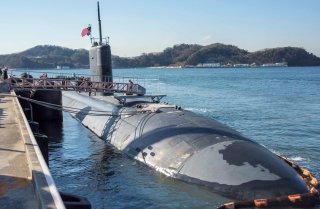
Here's What You Need To Remember: USS Thresher sank on April 10, 1963, with 129 sailors onboard. It was the first nuclear submarine disaster, and to this day, has the highest death toll. Unlike with Scorpion, the U.S. Navy has reported exactly what caused Thresher to sink—poor quality control.
Since the Second World War, the United States, Russia and China—and a host of other nations—have lost vessels and their crews to accidents. Operating submarines is a risky business under the best of circumstances—and will likely remain so. Even the highest technology nuclear submarines can end up on the ocean floor if the crew isn’t careful or the technology fails.
Here are some of the worst submarine disasters of the past several decades.
Kursk, 2000
Perhaps the worst submarine disaster in recent memory was Russia’s loss of K-141 Kursk, which was a Project 949A Antey-class (Oscar II) nuclear-powered guided missile submarine. The massive 16,000-ton submarine was destroyed in a massive explosion on August 12, 2000—which killed all 118 members of its crew.
Kursk’s wreckage was eventually recovered and the accident was ultimately traced to the Type-65-76A torpedo. Though the weapon is powerful enough to destroy an aircraft carrier with a single hit, the Soviet Union inexplicably designed the torpedo to run on hydrogen peroxide fuel, which is highly volatile and requires careful handling. Unfortunately for Kursk’s crew, they apparently had neither the training nor the experience to handle those weapons.
After the Kursk disaster, the Russian Navy removed hydrogen peroxide-fuelled torpedoes from service.
Komsomolets, 1989:
K-278 Komsomolets was the only boat of the Project 685 Plavnik-class (NATO: Mike) ever completed. Designed primarily as a testbed for new technologies, the 8,000-ton Komsomolets was one of the highest performance submarines ever built—it had an operating depth greater than 3000ft. Like the Papa-class, Project 685 Plavnik was designed to test automation technologies and perfect the Soviet Union’s ability to built titanium pressure hulls.
The submarine sank on April 7, 1989, after a fire broke out onboard. The fire set off a chain of events that ultimately caused the boat to sink. Despite the heroic efforts of the crew, 42 of the 69 crewmembers were killed during the accident. However, only four people died as a direct result of the fire—the rest died from exposure. More of the crew might have been saved if the Soviet navy had acted more quickly to mount a rescue operation.
Meanwhile, Komsomolets’s nuclear reactor and its two nuclear warheads remain onboard the stricken hull under 5,500ft of water in the Barents Sea—a disaster waiting to happen again.
K-8, 1970:
K-8 was a Project 627A Kit-class (NATO: November) nuclear-powered attack submarine that sank after a fire in April 12, 1970. (K-8 didn’t have a name, the Soviet Union only rarely named its submarines)
The submarine had originally caught fire on April 8, 1970, during an exercise in two separate compartments. The fire apparently started as a result of oil coming into contact with the air regeneration system. After the fire spread throughout the boat via the air conditioning system—and the reactors shut down—the captain ordered the crew to abandon ship. The crew boarded the submarine again after a rescue vessel arrived. But eventually the submarine sank in heavy seas while undertow—with 52 members of its crew.
The Russians have had multiple incidents with fire onboard their submarines. Indeed, Russia’s first nuclear-powered attack submarine— K-3 Leninsky Komsomol —was nearly destroyed due to fire caused by a jury-rigged repair in September, 1967. “A non-standard gasket from. . . a beer bottle was installed in the ballast tank,” a former crewmember told Pravda. “Naturally it was displaced, the hydraulic fluid leaked under the pressure of 100 atmospheres and got sprayed onto the lamp, which had a broken protective cap. Inflammation occurred immediately.”
USS Scorpion (SSN-589), 1969
While Russia and the Soviet Union have had their fair share of submarine disasters, the United States Navy has lost submarines too. On May 22, 1969, the USS Scorpion, a Skipjack-class attack submarine. was lost with all hands 400 miles southwest of the Azores islands. There were 99 sailors onboard.
It is still a mystery as to what exactly happened to Scorpion—the boat simply failed to return to port on May 27 that year. The Navy launched a search, but eventually declared it lost on June 5. Eventually, Scorpion was located under 10,000ft of water by a Navy research ship later that year.
U.S. Navy source tell me they have a good idea about what probably happened to Scorpion—but didn’t provide any details. Most public sources, suggest that the most likely cause was an inadvertent activation of the battery of a Mark 37 torpedos or a torpedo explosion.
USS Thresher (SSN-593), 1963:
USS Thresher sank on April 10, 1963, with 129 sailors onboard. It was the first nuclear submarine disaster, and to this day, has the highest death toll. Unlike with Scorpion, the U.S. Navy has reported exactly what caused Thresher to sink—poor quality control.
The submarine sank while it was conducting a dive to its test depth of about 1,300ft. Five minutes prior to losing contact with the vessel, the submarine rescue ship Skylark received a garbled UQC transmission (an underwater radio of sorts) that said Thresher was having some minor technical difficult. Skylark continued to receive garbled messages until the sonar picked up the sound of Thresher imploding.
A Navy court of inquiry found that a piping failure probably caused the accident.
As the boat’s engine room flooded as a result, salt-water spray shut down the nuclear reactor. Subsequently, Thresher’s main ballast tank failed to blow after ice formed in its piping. The crew was unable to access the equipment needed to stop the flooding.
As a direct result of the Thresher disaster, the Navy instituted the SUBSAFE program to ensure that there is a thoroughly documented system of checks and re-checks on all critical components of a nuclear sub.


No comments:
Post a Comment